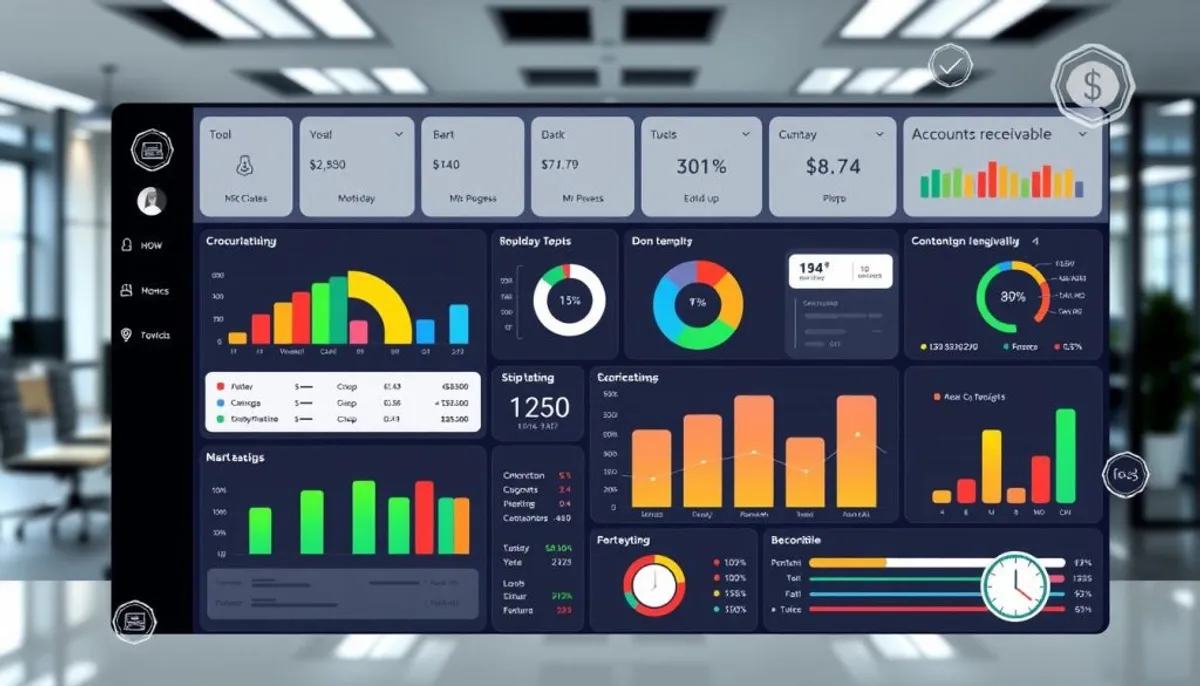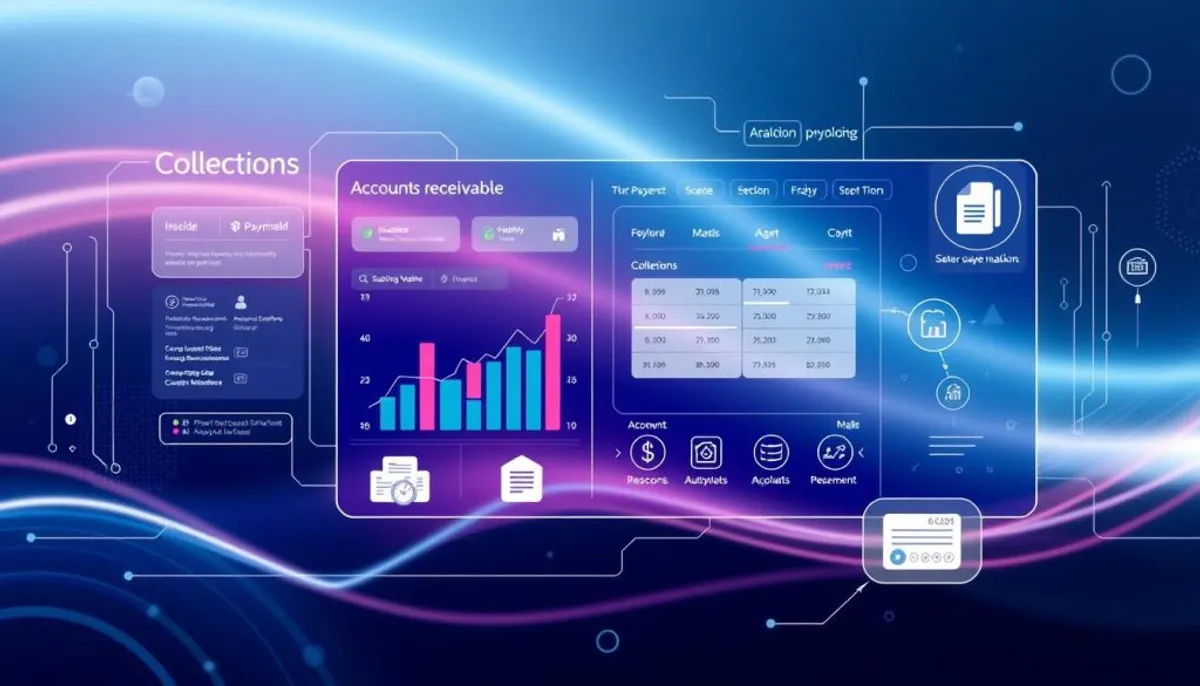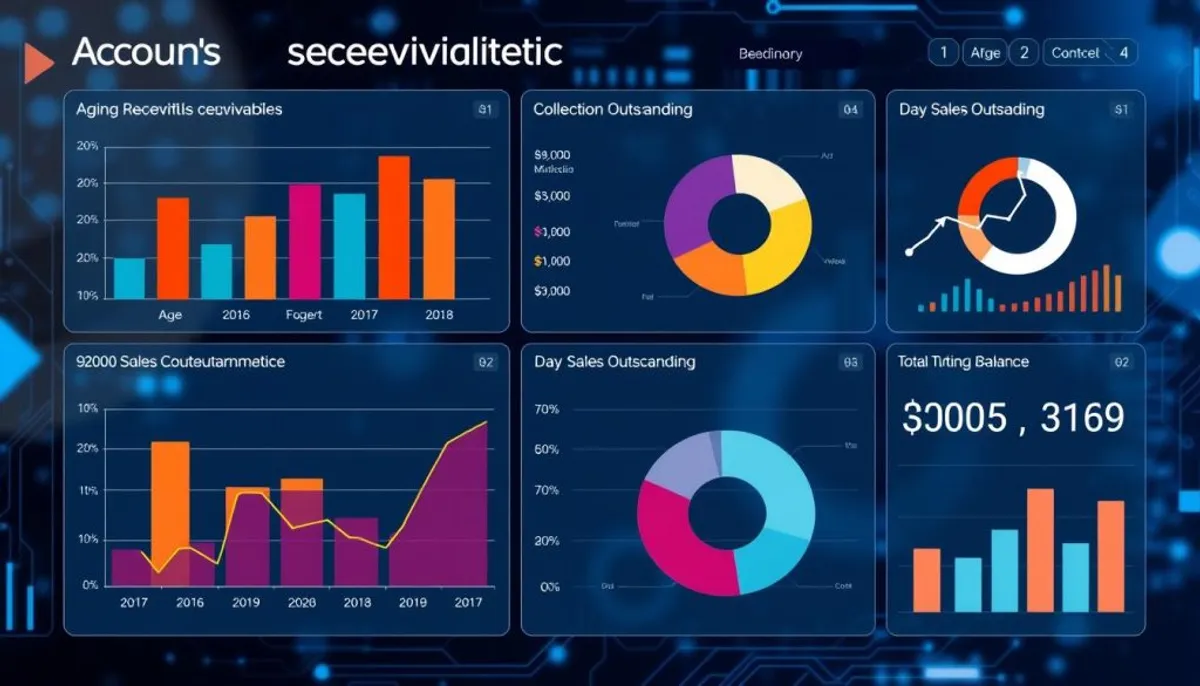Envision a realm where your business’s cash flow operates with precision, akin to a finely tuned machine. This is the essence of an effective accounts receivable system. It transcends mere invoicing, embracing intelligent invoice processing and customer billing to sustain your enterprise’s vitality.
It’s alarming to note that 25% of businesses face financial peril due to delayed payments. Yet, there’s a beacon of hope. By integrating automation into your accounts receivable system, you can significantly reduce the time invested in payment pursuit. This, in turn, enhances your Days Sales Outstanding (DSO).

The advent of electronic billing and payment systems is transformative. They operate in real-time, eliminating the errors that impede customer payments. This innovation is akin to infusing your cash flow with a turbocharger.
Key Takeaways
- An efficient accounts receivable system is crucial for business success
- Automating invoicing can reduce payment collection time by 80%
- Electronic billing improves payment efficiency
- Aim to keep Days Sales Outstanding (DSO) below 30 days
- Track key metrics like accounts receivable turnover ratio and Collection Effectiveness Index
Understanding Accounts Receivable System Fundamentals
Accounts receivable systems are vital for managing a company’s financial health. They oversee the collection of payments for goods or services sold on credit. Let’s dive into the essential components and advantages of an efficient AR system.
Core Components of AR Systems
A well-structured AR system includes tools for creating invoices, tracking payments, and managing credits. These elements collaborate to ensure prompt collection and minimize delinquent accounts. A critical feature is the accounts receivable aging schedule. It categorizes unpaid invoices by their age.
Benefits of Streamlined Collections
Streamlined collections bring significant benefits:
- Faster payment cycles
- Improved cash flow
- Reduced bad debt
- Enhanced customer relationships
For instance, Apple Inc. showcased an impressive accounts receivable turnover ratio of 13.2 in Q4 2021. This highlights their effective collection practices.
Impact on Business Cash Flow
Effective AR management profoundly affects cash flow. By shortening the average sales credit period, businesses can enhance liquidity. A turnover ratio of 30 equates to an average payment period of just 1.73 weeks. This ensures a steady influx of cash. Such improved cash flow enables companies to fulfill short-term obligations without needing extra financing.
The True Cost of Late Payments to Your Business
Late payments can severely impact your business’s financial health. The effects extend beyond mere cash flow management issues. We will explore the true costs of delayed payments and their impact on your company’s profitability.
Did you know that 87% of businesses face late payments? Even more concerning, 60% report payments arriving 15 or more days past due. This widespread issue leads to significant challenges in accounts aging and financial stability.
The time spent on late payments is substantial. Mid-sized businesses in the US spend up to 14 hours weekly on this, totaling over 700 hours annually. This time could be better invested in growth strategies and core business activities.
Financial implications go beyond wasted time. Late payments increase days sales outstanding (DSO), creating a cash trap. They also deteriorate accounts receivable quality, potentially leading to higher provisions for uncollectible accounts.
| Impact | Consequence |
|---|---|
| Increased DSO | Cash flow constraints |
| Deteriorated AR quality | Higher bad debt provisions |
| Reduced financing availability | Limited growth opportunities |
| Damaged relationships | Lost business partnerships |
The ripple effect of late payments extends to personal well-being. About 75% of UK business owners report that late payments negatively impact their sleep and stress levels. This can lead to serious health issues, affecting not just the business but also personal lives.
Implementing effective cash flow management strategies and optimizing your accounts aging process are crucial steps in mitigating these risks. By doing so, you can safeguard your business’s financial health and ensure sustainable growth.
Essential Features of Modern AR Management
Modern accounts receivable (AR) systems are equipped with advanced features to streamline the collections process. These tools are designed to help businesses address slow payments and minimize billing errors.
Invoice Generation and Processing
Advanced AR software automates the creation and delivery of invoices. This significantly reduces manual labor and accelerates billing cycles. Digital invoicing enables companies to dispatch bills promptly and monitor their status in real-time.
Payment Tracking Capabilities
Robust tracking tools empower firms to monitor incoming payments effortlessly. AR systems integrate with bank accounts to record transactions immediately. This provides businesses with a transparent view of their cash flow at any given time.
Automated Reminder Systems
Smart payment reminders are a transformative element in collections. AR software can dispatch customized reminders to customers at predetermined intervals. This approach often leads to quicker payments without compromising client relationships.
These features enable modern AR management systems to reduce late payments and enhance cash flow. They liberate staff from tedious tasks, diminish errors, and expedite payment receipt. For companies aiming to bolster their financial health, investing in superior AR software is a prudent decision.
Introducing ti3: Your Complete Collection Solution
ti3 represents a groundbreaking SaaS platform, poised to transform your accounts receivable system. It addresses the pressing issue of overdue payments with a streamlined approach to customer billing and collection.

Manual invoice processing can incur substantial costs, up to $20 per invoice. ti3 automates this process, drastically reducing expenses. It achieves an 80% reduction in processing time and a 66% decrease in errors.
Late payments can severely impact your business’s resources. SMEs often wait over two months for overdue invoices, with 90% experiencing negative effects. ti3 streamlines your collections, significantly shortening payment times compared to traditional methods.
- Automated reminders to prompt timely payments
- Efficient escalation of overdue accounts
- Seamless payment collection from late-paying customers
- Preservation of valuable client relationships
Choosing ti3 means more than adopting an accounts receivable system. It signifies a shift towards a cost-effective alternative to traditional debt collection agencies. With ti3, you can foster strong customer relationships while enhancing your accounts receivable management outcomes.
Building an Effective Collections Strategy
A robust collections strategy is essential for maintaining a healthy cash flow. It involves establishing clear payment terms, crafting effective communication templates, and setting up escalation procedures. These steps help streamline the collections process and enhance payment tracking.
Developing Payment Terms
Clear payment terms form the cornerstone of a successful collections strategy. Offering a 2/10, net/30 discount can accelerate receivables. This approach incentivizes customers to pay within 10 days for a 2% discount, rather than waiting the full 30 days. To further boost cash flow, consider implementing electronic payment options like Automated Clearing House (ACH).
Creating Communication Templates
Effective communication is pivotal for successful collections. It’s important to develop templates for each stage of the payment cycle:
- Friendly reminders 3-5 days before the due date
- Follow-up on the due date if payment is not received
- Phone calls 7-10 days after the due date
Establishing Escalation Procedures
Develop a clear escalation process for overdue payments. After 30 days, consider more serious collection efforts. Implementing a deposit requirement and late payment penalties can encourage timely payments. For clients facing cash flow challenges, offering payment plans can help maintain relationships while improving collections.
| Days Overdue | Action | Communication Method |
|---|---|---|
| 0-5 | Friendly Reminder | |
| 6-15 | Follow-up | Email and Phone |
| 16-30 | Urgent Notice | Phone and Certified Mail |
| 31+ | Escalation | Legal Notice |
Implementing these strategies can significantly enhance a business’s collections process and maintain a healthy cash flow. Regularly evaluating your collections strategy ensures continuous improvement and adaptation to changing business needs.
Automation Technologies in AR Processing
Automation technologies are transforming accounts receivable systems. These innovations streamline invoice processing, diminish manual errors, and enhance cash flow. With AI-driven solutions, businesses can save over 70% on invoicing costs.
Modern AR automation software features interactive interfaces and real-time data access. This empowers analysts to make strategic decisions swiftly. The impact on efficiency is substantial, with automated systems reducing days sales outstanding and encouraging faster payments.
Key benefits of AR automation include:
- Simplified invoice creation and delivery
- Seamless payment tracking
- Automated payment reminders
- Effortless report generation
These features lead to quicker invoice settlements and improved liquidity. In fact, companies using automated AR tools collect payments 67% faster than those relying on manual processes.
| Metric | Impact of AR Automation |
|---|---|
| Cost Savings | Up to 70% reduction in invoicing expenses |
| Overdue Accounts | 70% reduction |
| Cash Application Speed | 75% faster |
| Collection Time | 67% faster than manual processes |
By embracing automation in accounts receivable systems, businesses can significantly enhance their financial operations. The result is improved cash flow, reduced errors, and more time for high-value tasks.
Customer Communication Best Practices
Effective communication is paramount for successful collections. Implementing good billing practices can greatly influence your business’s cash flow and customer relations. We will examine essential strategies for managing payment reminders and resolving disputes.
Timing of Payment Reminders
Timely payment reminders are vital. Begin with a courteous reminder before the due date. This approach can diminish late payments and demonstrate your appreciation for their business. A Balance Payments Inc. study revealed that 83% of customers prioritize a seamless payment experience when selecting suppliers.
Professional Communication Approaches
Employ clear, concise language in your communications. Provide various channels for customers to contact you, such as phone, email, or chat. This adaptability can enhance response rates and customer satisfaction. It’s noteworthy that 84% of executives deem customer experience crucial to Accounts Receivable practices.
Dispute Resolution Protocols
Develop a clear process for dispute resolution. Engage with customer concerns and document all interactions. Remain professional and composed, even with challenging customers. Consider offering one-time concessions to preserve relationships when necessary. Prompt resolution of issues can prevent minor issues from escalating.
| Communication Practice | Impact on Business |
|---|---|
| Proactive Reminders | Reduces late payments by 30% |
| Clear Language | Improves understanding by 45% |
| Multi-Channel Support | Increases response rates by 25% |
| Efficient Dispute Resolution | Lowers customer churn by 20% |
Measuring AR Performance and Success
Monitoring accounts receivable (AR) performance is essential for managing cash flow effectively. By tracking key metrics, businesses can refine their collection strategies and enhance their financial standing.
Key Performance Indicators
AR teams must focus on several critical metrics to assess their success. The accounts receivable turnover ratio is a key indicator, measuring how frequently a company collects its average receivables in a year. A ratio of 7.5 times per year signifies efficient collection practices.
Collection Effectiveness Index
The Collection Effectiveness Index (CEI) gauges a company’s payment recovery efficiency within a set timeframe. To compute CEI, apply the following formula:
CEI = (Beginning Receivables + Current Sales – Ending Total Receivables) / (Beginning Receivables + Current Sales – Ending Current Receivables) x 100
A CEI nearing 100% signifies superior collection performance.
Days Sales Outstanding Analysis
Days Sales Outstanding (DSO) reflects the average days to collect payment post-sale. A lower DSO indicates quicker collections and enhanced cash flow management. To calculate DSO, follow this formula:
DSO = (Accounts Receivable / Total Credit Sales) x Number of Days in Period
| Metric | Good Performance | Average Performance | Poor Performance |
|---|---|---|---|
| AR Turnover Ratio | Above 8 times/year | 6-8 times/year | Below 6 times/year |
| Collection Effectiveness Index | Above 80% | 70-80% | Below 70% |
| Days Sales Outstanding | Below 45 days | 45-60 days | Above 60 days |
Regularly analyzing these metrics aids businesses in pinpointing areas for improvement in their accounts aging processes and cash flow management strategies.

Integration with Existing Business Systems
Integrating your accounts receivable system with existing business software is crucial for streamlined operations. A well-integrated system can lead to significant improvements in financial management and efficiency.
Companies that integrate their AR systems with Enterprise Resource Planning (ERP) solutions often see remarkable results:
- 77% reduction in receivables at risk
- 60% reduction in overdue invoices
- 30% improvement in days sales outstanding
These improvements are not just numbers. They translate to better cash flow, which is vital for business survival. In fact, about 82% of small businesses fail due to cash flow problems.
When choosing an accounts receivable system, look for solutions that can seamlessly connect with popular accounting software like Xero and QuickBooks. This integration enables real-time data synchronization, reducing manual data entry and potential errors in invoice processing.
The best AR systems also integrate with customer relationship management (CRM) tools and payment gateways. This creates a comprehensive financial management solution that streamlines your entire accounts receivable process.
| Integration Benefits | Impact |
|---|---|
| Enhanced financial visibility | Better decision-making |
| Improved cash flow management | Reduced risk of business failure |
| Streamlined invoicing | Faster payments |
| Better customer relationship management | Increased customer satisfaction |
By integrating your accounts receivable system with your existing business systems, you’re not just improving efficiency – you’re setting your business up for long-term success.
Maintaining Customer Relationships During Collections
The art of balancing payment collection with customer retention is a delicate endeavor. A strategic approach to billing can significantly influence your business’s financial health and future prospects.
Balancing Firmness with Flexibility
In managing overdue accounts, a firm yet flexible stance is paramount. Studies indicate that 37% of CFOs intend to dispatch invoices promptly to bolster cash reserves. This strategy, complemented by timely reminders and notifications, effectively prompts payment without jeopardizing customer rapport.
Offering Payment Plans
For those facing temporary financial hurdles, payment plans offer a mutually beneficial solution. Such flexibility aids in the recovery of receivables while fostering goodwill. It’s noteworthy that retaining an existing customer is significantly less costly than acquiring a new one.
Building Long-term Trust
Establishing trust is crucial for sustaining positive customer interactions during the collections phase. Educate your team in negotiation, communication, and ethics to ensure effective collections without compromising loyalty. Initiatives like early payment incentives and diverse payment choices can enhance liquidity and fortify customer bonds.
| Strategy | Impact on Collections | Impact on Customer Relationships |
|---|---|---|
| Immediate Invoicing | Enhances cash flow | Shows professionalism |
| Payment Plans | Improves collection rates | Demonstrates flexibility |
| Early Payment Incentives | Accelerates payments | Builds goodwill |
| Multiple Payment Options | Speeds up collections | Enhances customer convenience |
Legal Compliance and Best Practices
In the realm of accounts receivable systems and collections processes, legal compliance is paramount. Law firms must navigate a complex landscape of regulations to ensure ethical and lawful practices. Understanding and adhering to debt collection laws, such as the Fair Debt Collection Practices Act (FDCPA) in the United States, is crucial.
Implementing best practices in your accounts receivable system can significantly improve collection rates. For instance, a study showed that law firms aiming for a 95% or higher collection rate often achieve better financial stability. Clear invoicing, timely billing, and offering multiple payment options are key strategies to boost collection efficiency.
To maintain legal compliance while optimizing your collections process, consider these best practices:
- Enforce a consistent invoicing cadence
- Send automatic payment reminders
- Offer flexible payment plans for clients facing financial difficulties
- Utilize accounts receivable aging reports to tailor collection methods
- Keep accurate records of all communications and payment history
By integrating these practices into your accounts receivable system, you can improve cash flow, reduce billing errors, and maintain positive client relationships. Remember, the goal is to balance firm financial health with ethical and compliant collection practices.
| Payment Due Date | Collection Rate Target | Recommended Payment Options |
|---|---|---|
| 30-60 days | 95% or higher | Debit/credit cards, eChecks, ACH transfers |
Conclusion
An efficient accounts receivable system is crucial for effective cash flow management. Automation can save up to 80% per invoice and handle thousands of electronic invoices annually. This approach reduces costs and minimizes manual errors, ensuring accurate invoicing and payment processing.
Providing multiple payment options and a 24/7 accessible payment portal can significantly reduce Days Sales Outstanding (DSO). These strategies, along with clear credit policies, expedite payments and enhance cash flow. An AR management solution enables businesses to reinvest in growth, boosting profitability and financial stability.
Regularly monitoring AR aging reports and maintaining strong customer relationships are vital for timely action on delinquent accounts. This proactive approach resolves payment issues quickly and fosters customer loyalty. Given that 82% of small businesses fail due to poor cash flow management, an effective accounts receivable system is not just beneficial—it’s essential for long-term success.
RelatedRelated articles



